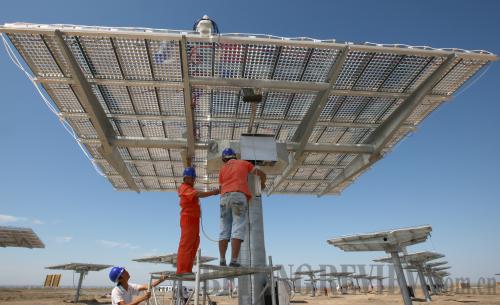|
 |
|
UTILIZING SUNSHINE: Workers install a solar panel in a photovoltaic industrial park in Hami, Xinjiang Uygur Autonomous Region, on August 6 (XINHUA) |
The name Xinjiang literally translates into "new frontier," and the name of the autonomous region rings especially true as China looks to expand its new energy market. Companies are flocking to Xinjiang to build alternative energy plants, wind farms and new energy parts production factories. The region has become a powerhouse for the energy industry and is paving the way for China's recent efforts to foster sustainable energy.
Hami Prefecture has become one of Xinjiang's hot spots for energy. It provides 12.5 percent of China's coal and is the 14th largest coal producer in China. But Zhang Wenquan, Deputy Secretary of Hami Prefectural Party Committee, said that now the city's priority is to shift toward more sustainable options. "We want to transfer to wind and solar energy instead of coal and gas," he said.
Xinjiang is already the largest base of wind power in China. It has nine wind farms, three of which are in Hami. At Naomahu Wind Farm in Yiwu County of Hami, 99 soaring wind turbines stretch across the horizon—the area is so vast that it's impossible to see anything outside of the plant. The first phase of the plant consists of 66 smaller turbines, with a capacity of 750 kw each. The second phase has 33 larger turbines with a capacity of 1,500 kw each. Each phase has a 50,000-kw capacity, and the plant has generated 320 million killowatt hours (on average, 10 million kwh per week) since its completion last year; in China, only seven wind-powered plants have generated over 10 million kwh. The power capacity of Naomahu Wind Farm is more than enough for all of Yiwu.
Naomaohu Wind Farm plans to provide energy to outside regions, and is building a route from the south of Hami to Zhengzhou, Henan Province; it is also planning a route from the north of Hami to Chongqing. The strength of the wind at the plant is a wonder of nature—it is almost impossible to even hear other people speak—and Naomaohu Wind Farm has found a way to harness this resource for the benefit of people in and outside of Xinjiang.
In contrast, at Hami Focusic Solar Co., the air is still and the heat is high. Sun powers down on this sandscape where larger-than-life solar panels dot the surface. This solar plant is still under construction, but the technology Focusic employs is impressive. Each panel encases thousands of solar-powered batteries—each one could fit into the palm of a hand. The batteries are topped with a strong magnifying glass that concentrates the sun's rays to hit the copper battery at full strength, utilizing simple and inexpensive methods to maximize efficiency. "We don't use any rare materials for these batteries," said Wang Junxin, a spokesperson of Hami Focusic. "We just use common glass and common copper." Each panel is designed to automatically pivot toward the sun in order to get as much direct sunlight as possible; so far, only the United States, Germany and Spain have employed this technology.
Despite the advances in alternative energy in Xinjiang, it is inevitable that the region will also exploit its wealth of coal reserves. But technology has made it possible to generate power from coal in a relatively sustainable and responsible way. Guanghui New Energy Ltd. in Yiwu employs technology imported from Germany to produce dimethyl ether, methanol and liquid natural gas from coal; it will be the first company in China to produce all three. The company built the plant in December 2011, and it is still in trial. It plans to bring in 5 billion yuan ($793.65 million) a year in revenue, and export 1.2 million tons of methanol, 500 million cubic meters of natural gas and 850,000 tons of dimethyl ether each year.
Guanghui New Energy brings coal from 40 km away and processes it to extract liquid natural gas and then dimethyl ether, until only methanol is left. During the process, the plant recycles ammonia and water in order to not waste these resources. "We use every useful thing from coal," said chief engineer Guo Jianmin. "We pretty much recycle all of the water we use—other factories release nearly eight times as much water as we do." Guo also said that for every 2,800 cubic meters of water used, the plant releases only 90 cubic meters of water, which is mostly salt and not harmful to the environment. It isn't hard to see why Guanghui New Energy set up shop in Xinjiang; in Shanxi Province, coal costs 1,000 yuan ($158.73) per ton, whereas in Xinjiang, it costs a fraction of the price at only 50 yuan ($7.94) per ton.
According to Zhang, the new energy ventures are a boon for locals. Currently, Hami is expanding its infrastructure with the aid of these companies—new highways and a high speed railroad, among others, are in construction. Most importantly, the plants create jobs for the people of Hami and Xinjiang at large, both at the plants themselves and also at the factories that supply the plants' equipment. Zhang expects to see 10,000 jobs created each year from new developments.
The author is a copy editor of Chinafrica magazine
Email us at: yushujun@bjreview.com |
